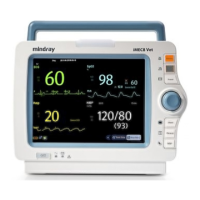11-5
Sat-Seconds= Points × Seconds
Only when the Sat-Seconds limit is reached, the monitor gives a Sat-Seconds alarm. For example, the figure below
demonstrates the alarm response time with a Sat-Seconds limit set at 50 and a low SpO
2
limit set at 90%. In this example,
the patient % SpO
2
drops to 88% (2 points) and remains there for 2 seconds. Then it drops to 86% (4 points) for 3 seconds,
and then to 84% (6 points) for 6 seconds. The resulting Sat-Seconds are:
% SpO
2
Seconds Sat-Seconds
2× 2= 4
4× 3= 12
6× 6= 36
Total Sat-Seconds= 52
After approximately 10.9 seconds, a Sat-Second alarm would sound, because the limit of 50 Sat-Seconds would have
been exceeded.
Saturation levels may fluctuate rather than remaining steady for a period of several seconds. Often, the patient % SpO
2
may fluctuate above and below an alarm limit, re-entering the non-alarm range several times. During such fluctuation,
the monitor integrates the number of % SpO
2
points, both positive and negative, until either the Sat-Seconds limit is
reached, or the patient % SpO
2
re-enters the non-alarm range and remains there.
11.5.7 Changing the Speed of the Pleth Wave
In the [SpO
2
Setup] menu, select [Sweep] and then select the appropriate setting. The faster the waveform sweeps, the
wider the waveform is.
11.5.8 Setting the Alarm Level for SpO
2
Sensor Off Alarm
Select [Alarm Setup >>] from the [User Maintenance] menu. You can set the [SpO2SensorOff Lev.] in the popup
menu.
Seconds
SpO
2

